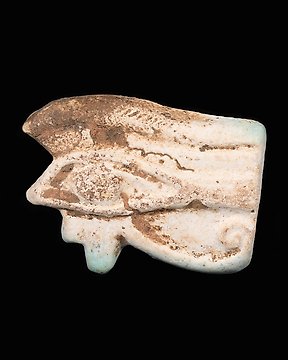
Det Gamle Egypten, Den Sene Periode Fajance Stor øje af Horus Amulet (Ingen mindstepris)
Nr. 83736845

Nr. 83736845

ITEM: Eye of Horus 'Udjat eye' amulet
MATERIAL: Faience
CULTURE: Egypt
PERIOD: Late period, 644 - 332 B.C
DIMENSIONS: 11 mm x 15 mm
CONDITION: Good condition
PROVENANCE: Ex English private collection, H.N., Milton Keynes, acquired between 1980s - 1990s
The Eye of Horus, wedjat eye or udjat eye is a concept and symbol in ancient Egyptian religion that represents well-being, healing, and protection. It derives from the mythical conflict between the god Horus with his rival Set, in which Set tore out or destroyed one or both of Horus's eyes and the eye was subsequently healed or returned to Horus with the assistance of another deity, such as Thoth. Horus subsequently offered the eye to his deceased father Osiris, and its revivifying power sustained Osiris in the afterlife. The Eye of Horus was thus equated with funerary offerings, as well as with all the offerings given to deities in temple ritual. It could also represent other concepts, such as the moon, whose waxing and waning was likened to the injury and restoration of the eye.
The Eye of Horus symbol, a stylized eye with distinctive markings, was believed to have protective magical power and appeared frequently in ancient Egyptian art. It was one of the most common motifs for amulets, remaining in use from the Old Kingdom (c. 2686–2181 BC) to the Roman period (30 BC – 641 AD). Pairs of Horus eyes were painted on coffins from the First Intermediate Period (c. 2181–2055 BC) and Middle Kingdom (c. 2055–1650 BC). Other contexts where the symbol appeared include on carved stone stelae and on the bows of boats. To some extent the symbol was adopted by the people of regions neighboring Egypt, such as Syria, Canaan, and especially Nubia.
The ancient Egyptian god Horus was a sky deity, and many Egyptian texts say that Horus's right eye was the sun and his left eye the moon. The solar eye and lunar eye were sometimes equated with the red and white crown of Egypt, respectively. Some texts treat the Eye of Horus seemingly interchangeably with the Eye of Ra, which in other contexts is an extension of the power of the sun god Ra and is often personified as a goddess. The Egyptologist Richard H. Wilkinson believes the two eyes of Horus gradually became distinguished as the lunar Eye of Horus and the solar Eye of Ra. Other Egyptologists, however, argue that no text clearly equates the eyes of Horus with the sun and moon until the New Kingdom (c. 1550–1070 BC); Rolf Krauss argues that the Eye of Horus originally represented Venus as the morning star and evening star and only later became equated with the moon.
Katja Goebs argues that the myths surrounding the Eye of Horus and the Eye of Ra are based around the same mytheme, or core element of a myth, and that "rather than postulating a single, original myth of one cosmic body, which was then merged with others, it might be more fruitful to think in terms of a (flexible) myth based on the structural relationship of an Object that is missing, or located far from its owner". In the myths surrounding the Eye of Ra, the goddess flees Ra and is brought back by another deity. In the case of the Eye of Horus, the eye is usually missing because of Horus's conflict with his arch-rival, the god Set, in their struggle for the kingship of Egypt after the death of Horus's father Osiris.
Comes with Certificate of Authenticity and Export license
If you bid outside the European Union and win the item, we will have to apply for an export licence for your country and shipping will take 3 to 5 weeks.
Sådan køber du hos Catawiki
1. Opdag noget særligt
2. Afgiv det højeste bud
3. Foretag en sikker betaling